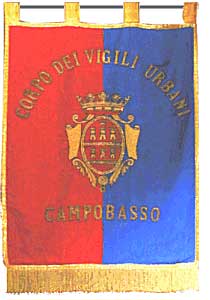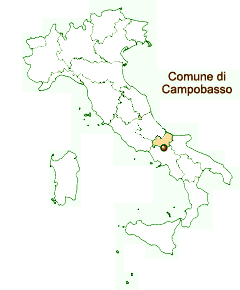|
|
|

Campobasso — Comune di Campobasso
 Campobasso is located in the Molise region of south central Italy and is the name of both a province (Provincia di Campobasso), as well as the capital city (Comune di Campobasso). The citi has a population of 50,000+ and is located in the high basin of the Biferno river, surrounded by the Sannio and Matese mountains. Campobasso is renowned for the craftmanship of blades (including scissors and knives), historically documented since the 14th century. It also famous for the production of pears and scamorza (cheese).
Campobasso is located in the Molise region of south central Italy and is the name of both a province (Provincia di Campobasso), as well as the capital city (Comune di Campobasso). The citi has a population of 50,000+ and is located in the high basin of the Biferno river, surrounded by the Sannio and Matese mountains. Campobasso is renowned for the craftmanship of blades (including scissors and knives), historically documented since the 14th century. It also famous for the production of pears and scamorza (cheese).
The origins of Campobasso are still disputed. According to the most agreed theory, the city was founded before the 8th century as a fortified camp by the Lombards, on the steep of the hill where a castle is. The original name was Campus vassorum, meaning the city was in origin the seat of the vassals of the Duke of Spoleto.
After the Norman conquest of Southern Italy, Campobasso lost his connotation of defensive strongpoint and gained a role as trading and administration centre. From 1330 to 1745 the city was ruled by the Monforte-Gambatesa, who built the castle and established a mint. Later it was ruled by the Di Capua, Gonzaga, Vitagliano, Carafa and Romano families.
In 1763 the citizens abandoned the old city and settled in the lower valley. The current city was expanded in 1814 by the King of Naples Joachim Murat, and lies on the Campo Basso ("Low field"). In the October and November 1943 Campobasso was the centre of fights between the Allies and German troops. Several buildings and plant were destroyed, and 38 citizens were killed. In 1995 the city received the Bronze Medal for Civil Valour for the harsh work made by the Campobassani to clean all territory from dangerous unexploded warheads, a work that lasted well into 1948.
 The main attraction of Campobasso is the Castello Monforte, built in 1450 by the local ruler Nicola II Monforte, over Lombard of Norman ruins. The castle has Guelph merlons and lies on a commanding point, where traces of ancient settlements (including Samnite walls) have been found. The current construction is the result of later rebuildings after the earthquakes of 1456 and 1805. Next to the castle is the Chiesa della Madonna del Monte (Santa Maria Maggiore), erected in the 11th century and rebuilt in 1525. It houses a precious wooden statue of the Incoronata from 1334. At the feet of the castle, the church of St. George is probably the most ancient church of Campobasso, built around the year 1000 AD over the ruins of a Pagan temple.
The main attraction of Campobasso is the Castello Monforte, built in 1450 by the local ruler Nicola II Monforte, over Lombard of Norman ruins. The castle has Guelph merlons and lies on a commanding point, where traces of ancient settlements (including Samnite walls) have been found. The current construction is the result of later rebuildings after the earthquakes of 1456 and 1805. Next to the castle is the Chiesa della Madonna del Monte (Santa Maria Maggiore), erected in the 11th century and rebuilt in 1525. It houses a precious wooden statue of the Incoronata from 1334. At the feet of the castle, the church of St. George is probably the most ancient church of Campobasso, built around the year 1000 AD over the ruins of a Pagan temple.
The main church is the Cathedral, or Chiesa della Santissima TrinitÓ (Church of the Holy Trinity), was built in 1504 outside the city walls. It was destroyed by an earthquake in 1805 and a new Neoclassical edifice was built in 1829. The church of San Bartolomeo is a Romanesque building from the 11th century, in limestone. The interior has a nave and two aisles.
San Leonardo (14th century) has a fašade mixing Gothic and Romanesque elements, and a side mullioned window with vegetables decorations influenced by the Apulian architecture of the period. Villa de Capoa, recently restored, is a noteworthy garden with statues and a wide variety of vegetable species, including sequoias, Norway Spruces, cypresses and Lebanon Cedars.
 Comuni di Provincia di Campobasso
Comuni di Provincia di Campobasso
Cities and towns in the Province of Campobasso include:
Acquaviva Collecroce, Baranello, Bojano, Bonefro, Busso, Campobasso, Campochiaro, Campodipietra, Campolieto, Campomarino, Casacalenda, Casalciprano, Castelbottaccio, Castellino del Biferno, Castelmauro, Castropignano, Cercemaggiore, Cercepiccola, Civitacampomarano, Colle d'Anchise, Colletorto, Duronia, Ferrazzano, Fossalto, Gambatesa, Gildone, Guardialfiera, Guardiaregia, Guglionesi, Jelsi, Larino, Limosano, Lucito, Lupara, Macchia Valfortore, Mafalda, Matrice, Mirabello Sannitico, Molise, Monacilioni, Montagano, Montecilfone, Montefalcone nel Sannio, Montelongo, Montemitro, Montenero di Bisaccia, Montorio nei Frentani, Morrone del Sannio, Oratino, Palata, Petacciato, Petrella Tifernina, Pietracatella, Pietracupa, Portocannone, Provvidenti, Riccia, Ripabottoni, Ripalimosani, Roccavivara, Rotello, Salcito, San Biase, San Felice del Molise, San Giacomo degli Schiavoni, San Giovanni in Galdo, San Giuliano del Sannio, San Giuliano di Puglia, San Martino in Pensilis, San Massimo, San Polo Matese, Sant'Angelo Limosano, Sant'Elia a Pianisi, Santa Croce di Magliano, Sepino, Spinete, Tavenna, Termoli, Torella del Sannio, Toro, Trivento, Tufara, Ururi, Vinchiaturo.
American Immigrant Wall of Honor
Individuals with ties to Campobasso on the Wall of Honor at Ellis Island.
|
|





 Campobasso is located in the
Campobasso is located in the  The main attraction of Campobasso is the Castello Monforte, built in 1450 by the local ruler Nicola II Monforte, over Lombard of Norman ruins. The castle has Guelph merlons and lies on a commanding point, where traces of ancient settlements (including Samnite walls) have been found. The current construction is the result of later rebuildings after the earthquakes of 1456 and 1805. Next to the castle is the Chiesa della Madonna del Monte (Santa Maria Maggiore), erected in the 11th century and rebuilt in 1525. It houses a precious wooden statue of the Incoronata from 1334. At the feet of the castle, the church of St. George is probably the most ancient church of Campobasso, built around the year 1000 AD over the ruins of a Pagan temple.
The main attraction of Campobasso is the Castello Monforte, built in 1450 by the local ruler Nicola II Monforte, over Lombard of Norman ruins. The castle has Guelph merlons and lies on a commanding point, where traces of ancient settlements (including Samnite walls) have been found. The current construction is the result of later rebuildings after the earthquakes of 1456 and 1805. Next to the castle is the Chiesa della Madonna del Monte (Santa Maria Maggiore), erected in the 11th century and rebuilt in 1525. It houses a precious wooden statue of the Incoronata from 1334. At the feet of the castle, the church of St. George is probably the most ancient church of Campobasso, built around the year 1000 AD over the ruins of a Pagan temple.
 Comuni di Provincia di Campobasso
Comuni di Provincia di Campobasso